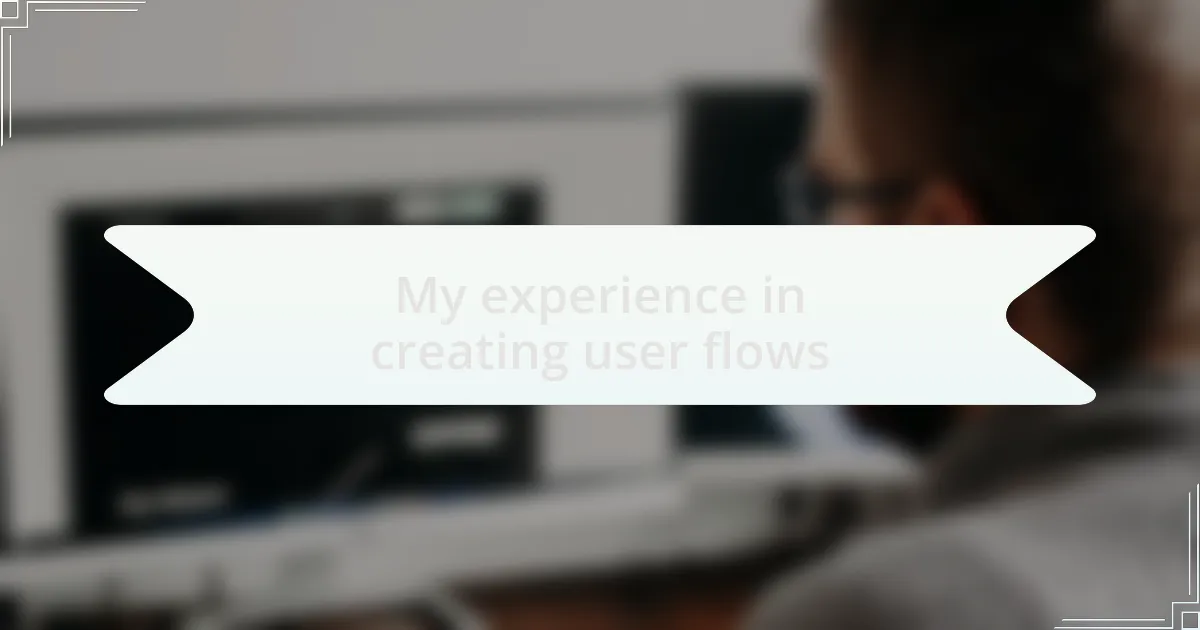Key takeaways:
- Utilizing tools like Lucidchart, Figma, and Miro enhances the process of creating and visualizing user flows.
- Understanding the target audience through research and building personas is crucial for effective flow design.
- Flexibility and adaptability in user flows are essential; feedback from usability testing can reveal crucial insights.
- Collaboration with diverse teams enriches the design process and fosters a sense of ownership among stakeholders.
Author: Oliver Bennett
Bio: Oliver Bennett is an acclaimed author known for his gripping thrillers and thought-provoking literary fiction. With a background in journalism, he weaves intricate plots that delve into the complexities of human nature and societal issues. His work has been featured in numerous literary publications, earning him a loyal readership and multiple awards. Oliver resides in Portland, Oregon, where he draws inspiration from the vibrant local culture and stunning landscapes. In addition to writing, he enjoys hiking, cooking, and exploring the art scene.
Tools for creating user flows
When it comes to creating user flows, I’ve found that tools like Lucidchart and Sketch can truly elevate the process. They offer intuitive drag-and-drop features that make mapping out complex flows straightforward and visually appealing. Have you ever struggled to visualize how users navigate your site? This kind of clarity can transform that struggle into confidence.
Another tool I often rely on is Figma, which not only allows for collaborative work but also streamlines the design process. I vividly remember the first time I collaborated in real-time with a developer; it was a game changer. How often do we get stuck in back-and-forth emails? With Figma, decisions happen instantly, creating a dynamic environment that enhances both productivity and creativity.
Additionally, I can’t overlook the power of Miro for brainstorming user flows. Its infinite canvas feels liberating, allowing me to map interactions and explore different user scenarios freely. In my experience, when I let go of boundaries, creativity flourishes. Have you tried sketching out ideas in such an open format? It opens up new dimensions in understanding user interactions that were previously overlooked.
Steps to design user flows
When designing user flows, the first step I take is to understand my audience thoroughly. I dive deep into user research, creating personas that represent my target users. This process has always helped me empathize with their needs, allowing me to visualize their journey through the product more clearly. Have you ever tried to step into your users’ shoes? It’s a powerful way to reshape your thinking about flow design.
Next, I outline the key actions users need to take to achieve their goals. For me, sketching these actions on paper before moving to digital tools has been invaluable. I recall one project where laying out a simple, hand-drawn flow revealed gaps I hadn’t considered, leading to a more streamlined design. It’s amazing how physical movement, even just with a pencil, can spark new ideas. Have you given sketching a shot before refining your flows digitally?
Lastly, I ensure I validate the user flows through usability testing. Inviting real users to navigate the flows I’ve created often uncovers insights I wouldn’t have predicted. There was a particular instance where users struggled with what I thought was an obvious step—this taught me that assumptions can lead to oversights. When was the last time you sought feedback on your designs? Those moments can be pivotal in guiding your final product toward success.
Lessons learned from my experience
One significant lesson I learned is the importance of flexibility in user flows. Early on, I had a project where I was so convinced of my initial design that I resisted making changes. However, after conducting user testing, I realized users struggled with navigation. That’s when I understood that adaptability is vital; sometimes, you must let go of your original vision to create something that truly serves the user’s needs. Have you ever clung to an idea only to find that it didn’t resonate with your audience?
Another key takeaway is the value of collaboration. When I worked with a cross-functional team, the diversity of perspectives enriched the design process. One brainstorming session revealed unique insights that I would have never considered alone. I’ve found that involving stakeholders early on not only enhances the user flow but also helps build a sense of ownership and commitment to the final product. Have you considered how collaboration might elevate your own design work?
Lastly, I learned that simplicity often leads to the best outcomes. On one occasion, I tried to incorporate multiple features into a single flow, hoping to impress the client. Instead, I ended up overwhelming the users. Streamlining the flow, focusing only on essential actions, was a game changer. It’s a reminder that clarity can drive engagement more effectively than complexity. When designing, have you asked yourself if you’re complicating the experience for your users?

Leave a Reply